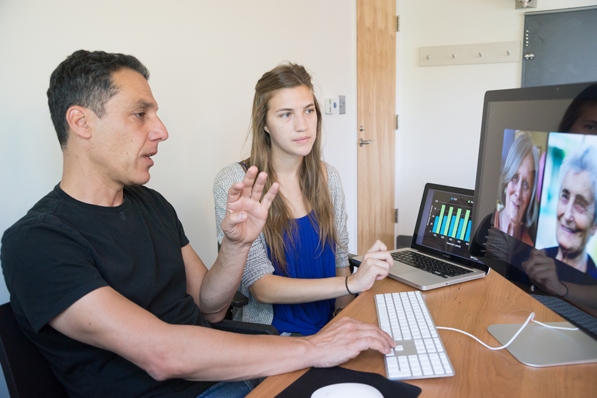Springtime on the Dartmouth campus marks the annual celebration of undergraduate research, scholarship, and creativity. Undergraduates work closely with faculty on projects relevant to the students’ chosen fields, challenge their abilities, and contribute to the scholarly enterprise. The projects are designed to encourage critical thinking, problem-solving abilities, self-confidence, and intellectual independence.
Dartmouth Now highlights the work of six undergraduate researchers in a weeklong series.
Olivia Holmes ’15, from Weston, Conn., was drawn to Dartmouth because it is a close-knit community that brings together students, faculty, and the town.

Olivia Holmes 15, right, with her adviser, Professor Hany Farid. Holmes says that without Farid’s guidance, her research “would not have reached the interesting and thoughtful conclusions that it did.” (Photo by Eli Burakian ’00)
She sees research as a door to discovering new knowledge. “Many times, the things that you discover through the research process are not at all what you had anticipated or hypothesized,” she says. “It is these unexpected things that can be your most interesting findings and demonstrate the utility of research most eloquently.”
With a major in computer science, modified with neuroscience, she considers herself fortunate to have been able to focus her research and her thesis on a subject that bridges both fields.
Her adviser, Hany Farid, had published a paper examining how reliable observers are at discriminating image type when presented with both computer generated (CG) and photographic faces. “As CG images quickly become more realistic, it becomes increasingly difficult for an average observer to make this distinction between the virtual and the real,” says Holmes.
Read more:
“My research looked into not only how reliable observers are at making this distinction, but also how their performance can be improved either by isolating features of the face or training them before the task. My original motivation was to update that study with more recent CG images and then take it one step further.”
“Olivia’s research required a broad set of skills and techniques from computer science, mathematics, neuroscience, and statistics,” says Farid, a professor of computer science. “She undertook an ambitious research project with important technological and legal implications. The results from her research will contribute to an important and growing body of research in the field of digital forensics.”
Farid says that because it is very difficult for untrained human observers to distinguish CG images from real photographic images, this can be problematic when a photograph is introduced into a court of law and the jury has to assess its authenticity. “We have found, however, that with some training, we can significantly improve observer performance on this task. We plan to see if we can further improve observer performance with the hopes of at least prolonging the day until computer generated images will be indistinguishable from real photographs,” he says.
“Without Professor Farid’s guidance, this research would not have reached the interesting and thoughtful conclusions that it did,” says Holmes.
In the fall, she will be moving to San Francisco to work at Apple.
